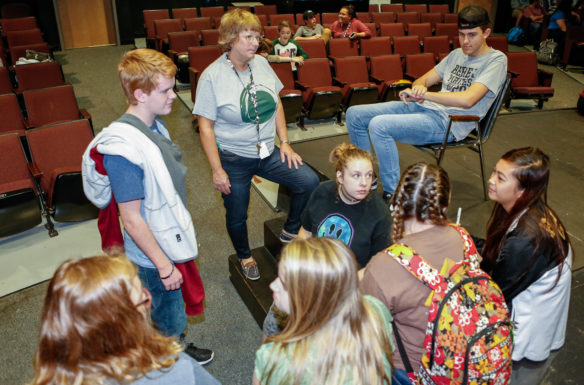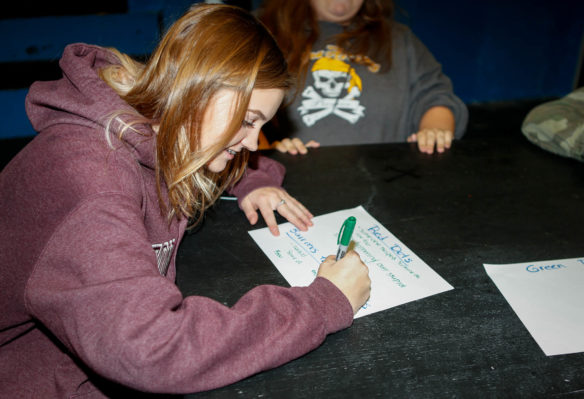
Diane Smith, center, coordinator of the family resource and youth service center at Berea Independent schools, listens as a group of students at Berea Community High School plan activities to raise awareness of the Green Dot bystander intervention program. The program encourages students to take action to prevent violence, both proactively and reactively.
Photo by Mike Marsee, Sept. 22, 2017
By Mike Marsee
mike.marsee@education.ky.gov
On the first club day of the year at Berea Community High School, the longest line at any of the tables was to sign up for Green Dot training.
The word had gotten out about Green Dot, a program that has helped reduce violence and improve the climate at the Berea Independent school, and students wanted in.
“They were coming to us, asking us to be trained on club day,” said Diane Smith, coordinator of the district’s family resource and youth service center. “They’ve heard it and they’ve seen it, and I think they want to be a part of that positive change.”
The Green Dot program has become an agent of positive change at schools across Kentucky and around the country by teaching students that violence is not acceptable and that they should do their part to prevent it.
The program is being used in hundreds of K-12 schools, colleges and communities to prevent violence through bystander intervention. Students are trained to recognize behavior and situations that could lead to violence (“red dots”) and identify ways they can safely intervene (“green dots”).
Students are trained to insert themselves into potentially violent situations without becoming victims themselves.
Berea Community is one of at least 30 Kentucky high schools that have adopted Green Dot. At the high school level, the focus is on the power of peer influence, as the program utilizes the most influential students in a school to ignite a cultural change.
“It’s had a major impact on our school system,” Berea Community High guidance counselor Eef Fontanez said. “We’ve seen a reduction of our discipline referrals, and we’ve seen kids actually using the language of Green Dot in the hallways and the classrooms, trying to de-escalate situations or identify situations.”

Hannah Caudill, a student at Berea Community High School (Berea Independent), notes instances of “red dot” behavior and barriers to “green dots” during a meeting of students who have been trained in the Green Dot program. About 125 students in the school have been trained in the program.
Photo by Mike Marsee, Sept. 22, 2017
Victoria Fields, a safe schools program consultant at the Kentucky Department of Education, said Green Dot is an attractive program because it addresses all students.
“Green Dot is very student-centered, and research is showing that the more you involve students in school change, the greater impact you have for the students,” Fields said.
Any student can take part in Green Dot training at Berea Community, where the program is in its third year, and many have. About 125 students have been trained, and another 99 want to be.
However, the program targets a specific type of student.
“The concept is to get not necessarily the most talkative kids, not necessarily the kids with the highest academic standing, but the most influential in whatever peer group they’re in. Once you reach those, then you can start reaching out to the other ones,” said Brian Hill, a violence prevention coordinator who leads the program at Berea Community and Madison Southern (Madison County) high schools as part of a grant administered by Saint Joseph Berea hospital.
The students’ training focuses on identifying two types of students who exhibit green dot behaviors:
- Proactive green dots send the message that violence will not be tolerated and that others are expected to do their part to keep the school environment safe. They might create social media campaigns, promote awareness or check in with friends and classmates.
- Reactive green dots respond to seeing concerning behavior or potential dangers, either to stop them from happening or to try to prevent them from getting worse. They might directly confront a situation, distract by changing the conversation or find someone better suited to defuse the situation, such as a teacher.
When it comes to being reactive, bystanders are empowered to take action, which Hill said isn’t a typical teenager’s response to an escalating situation.
“Right now, the immediate response to bullying or any kind of violent act, whether it’s in our schools or in society in general, is either, ‘I’m going to get away from this because I don’t want to be part of it,’ or ‘I’m going to pull out my cell phone and put it on social media,’” Hill said. “Neither one of those responses is OK, and we need to have some kind of option that we can do something to help the people involved. Also, it’s helping people be more aware that doing nothing is almost saying that it’s OK.”
Fields noted that Green Dot’s success is backed by research, including a study of Kentucky high schools indicated that the program is effective in reducing violence.
The study by the University of Kentucky’s Center for Research on Violence Against Women examined bystander intervention in 26 high schools participating in Green Dot over five years and found that the rates of sexual violence perpetration were reduced by about 20 percent. The rates of sexual harassment, stalking and dating violence victimization also fell in similar patterns.
“Most of the programs that I’ve seen over the years dealt primarily with the victims of bullying. This program is different in that it deals with prevention,” said Peggy Coyne, a retired teacher who works as a volunteer in the Berea Community program. “It gives the students that witness the bullying techniques on how to intervene without becoming a victim of the bullying. And I think that’s the success of the program – everybody can do it.”
The daylong trainings at Berea Community are intensive, and Smith said they can be personal.
“We talk about suicide, sexual abuse, all the hard topics,” Smith said. “Within that time frame, they look at their own weaknesses, they look at their own family dynamics, they look at their own situations and those of their friends. They share with us some of their deepest reasons why they chose to become involved with Green Dot. They’re very moving, very painful, very touching stories.
“These kids are wanting direction and how to deal with these issues, and their desire is there to make things better for themselves and help their fellow students.”
Amanda Hamilton, an English teacher at Berea Community, said she has seen a change in the school since Green Dot has taken hold.
“I really think that there has been a noticeable change in a lot of our students who maybe didn’t know how to overcome issues or how to help others before, but they wanted to,” Hamilton said. “And I think there’s been a very marked change in the culture around the school, just in people trying to be more helpful and be nicer to each other in general.”
Awareness of the program is extending beyond the school grounds. Students recently began planning a handful of awareness events, including a social media campaign, homecoming week activities and a parent night.
“They were talking about the importance of parents being open to talk to their children,” Smith said. “We always think it’s the other way around, but for them to be asking for their parents to be open to talk to them about different issues is huge. It spreads further than just bullying and bystanding; it gets to the real core of the problem.”
Smith said she’s convinced that the program already has saved lives at Berea, and Fontanez said Berea Community is a better school because of Green Dot.
“I think it has really reduced our issues of bullying and harassment, and I think it has created an awareness among the students and the faculty and parents,” he said. “School climate is an indicator of school success, and I think we’ll see a correlation in our test scores as well.”
MORE INFO …
Diane Smith diane.smith@berea.kyschools.us
Brian Hill brian_hill@berea.edu
Eef Fontanez eef.fontanez@berea.kyschools.us
Amanda Hamilton amanda.hamilton@berea.kyschools.us



Leave A Comment